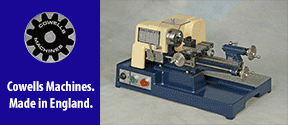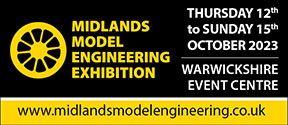Socket/thread sizes
Help!
| Simon Morrall | 13/01/2021 13:46:50 | |||||||||||||||||||||||||||||||||
| 11 forum posts 5 photos | Hi there new to this forum and apologies if this has already been covered (I've tried to look) I've acquired some Gedore sockets and they have several markings on. I understand some of them but am confused why they're all on one socket. I have a full set like this. Can someone explain what each of the marking means.. For example, one socket is marked with: 7/16 No.D1914 14SAE 11mm 1/4DIN Another socket is marked with: 29/32 No.D1929 1/2W 23mm I did try and look into all the different sizes and such but it's all gone a bit over my head. I don't know if the markings are referring to the thread or the head of the socket. Any help. Would be much appreciated as to what these markings mean. Thanks Simon
Edited By JasonB on 13/01/2021 17:01:08 | |||||||||||||||||||||||||||||||||
| Martin Connelly | 13/01/2021 18:19:14 | |||||||||||||||||||||||||||||||||
2549 forum posts 235 photos | Have you mixed up some of these numbers? It is a bi-hex socket in the list of their D19 sockets range. D19 14 means it is nominally 14mm across the flats of a hexagon and standard length. A D19L 14 would be a long reach version. The 14SAE is the designation of the across the flats size that will have some tolerance so that it slips on and off nuts and bolts easily. 29/32" (23.02mm) is close to 23mm and a 1/2" Whitworth wrench width is slightly over this 23mm figure at 0.929±.003" (23.6mm) so a 23mm socket is also a 29/32" socket and a 1/2" Whitworth socket as all have a very similar across the flats value. When I was buying tools as part of my job 19mm sockets were phased out and you bought a 3/4" socket instead since 3/4" is 19.05mm and the manufacturers saw no point in making and stocking 19mm and 19.05mm sockets. Martin C | |||||||||||||||||||||||||||||||||
| Simon Morrall | 14/01/2021 13:19:55 | |||||||||||||||||||||||||||||||||
| 11 forum posts 5 photos | Hi Martin,
Thanks for getting back to me. Yes definetely seem to be marked like that on the sockets. They've been punched in a work colleague suggested they were probably punched in at a later date before metric tools were available easily.
Thanks
Simon | |||||||||||||||||||||||||||||||||
| peak4 | 14/01/2021 13:48:16 | |||||||||||||||||||||||||||||||||
2207 forum posts 210 photos | Hello and welcome, by their shape, they look a bit like impact sockets, and also the lack of chrome or other plating might point that way. It may of course just be that they are old, before chrome plating was common on sockets. 7/16 will be the Across Flats (AF) size of the hex head it's designed to fit No.D1914 14SAE 11mm Again will be the Across Flats (AF) size of the hex head it's designed to fit 1/4DIN probably UNF/UNC 1/4" thread diameter, but about 11mm spanner size. Another socket is marked with: 29/32 Again will be the Across Flats (AF) size of the hex head it's designed to fit No.D1929 1/2W This is Whitworth(& BSF), and refers to the thread diameter, but the hex head is about 23mm or 29/32" across the flats 23mm Again will be the Across Flats (AF) size of the hex head it's designed to fit. not a preferred metric thread size, but often included in sets, so it can be used on 1/2" BSW fasteners.
Bill | |||||||||||||||||||||||||||||||||
| DC31k | 14/01/2021 13:51:37 | |||||||||||||||||||||||||||||||||
| 1186 forum posts 11 photos | Posted by Martin Connelly on 13/01/2021 18:19:14:
...The 14SAE is the designation of the across the flats size that will have some tolerance so that it slips on and off nuts and bolts easily. 29/32" (23.02mm) is close to 23mm and a 1/2" Whitworth wrench width is slightly over this 23mm figure at 0.929±.003" (23.6mm) so a 23mm socket is also a 29/32" socket and a 1/2" Whitworth socket as all have a very similar across the flats value. When I was buying tools as part of my job 19mm sockets were phased out and you bought a 3/4" socket instead since 3/4" is 19.05mm and the manufacturers saw no point in making and stocking 19mm and 19.05mm sockets. There are a couple of points you might need to clarify to give your analysis some weight. SAE is normally an abbreviation for 'Society of Automotive Engineers'. 'SAE socket', as a term, seems to be used as a contrast to 'metric socket'. The difference between 19mm and 19.05mm is at least an order of magnitude less than the difference between 23mm and 23.6mm. Using your logic for D1914, how do you explain D1929? | |||||||||||||||||||||||||||||||||
| SillyOldDuffer | 14/01/2021 15:05:44 | |||||||||||||||||||||||||||||||||
| 10668 forum posts 2415 photos | Intriguing, have a look at this graphic from Handtools. Their table should help. It's a guide to nearest fit spanner equivalents. So a 1/2" diameter bold, with roughly fit a 3/4" SAE spanner, or a metric 19mm spanner. Seems to match what you have: I guess D No is the manufacturers part number, not a size.
My reaction is yuk! The set enables someone to bash on without bothering to find the correct spanner for the bolt! For example 3/4" is 19.05 mm - too big. I don't care for loose fitting spanners because they tend to round the hexagon head. Bodge territory. The set may not be as nasty as I fear. Maybe it's deliberately made to split the difference between metric and SAE, and is a fair compromise between both systems. Thus 3/4" might be 0.749", which is metric 19.025, and a reasonable fit to both SAE and metric. You'd have to check. I wouldn't use it if there was any slack between socket and nut, other than for rough work. Dave
| |||||||||||||||||||||||||||||||||
| Martin Connelly | 14/01/2021 16:42:13 | |||||||||||||||||||||||||||||||||
2549 forum posts 235 photos | DC31k, Gedore have a series of sockets designated by them as D19. In that series D19 29 is a 29mm AF socket. What do you want explaining? I think the original post has some numbers from different sockets mixed up or the sockets have been marked by someone other than Gedore and they have made mistakes. Martin C | |||||||||||||||||||||||||||||||||
| peak4 | 14/01/2021 17:58:47 | |||||||||||||||||||||||||||||||||
2207 forum posts 210 photos | Re my earlier post, now I'm back from a stroll in the snow; bearing in mind these appear to be old German made sockets, I wonder is SAE then had a different usage and referred to a screw gauge.
That would tally nicely with a hex head being about 7/16" or 11mm. Bill
Edited By peak4 on 14/01/2021 18:03:51 | |||||||||||||||||||||||||||||||||
| Oily Rag | 14/01/2021 22:44:04 | |||||||||||||||||||||||||||||||||
550 forum posts 190 photos | I think Bill has hit the bolt on the head with his point about modern sockets are more likely to be 'wall drivers' rather than 'corner drivers'. This development led to the 'Metrinch' type of socket when manufacturers realised they could reduce stock levels by offering a product which favoured both Imperial and Metric sizes. That, added to the continuing reluctance of the Americans, and a fair few Brits, to abandon inch sizing! Martin | |||||||||||||||||||||||||||||||||
| Ady1 | 15/01/2021 09:11:27 | |||||||||||||||||||||||||||||||||
6137 forum posts 893 photos | Posted by Oily Rag on 14/01/2021 22:44:04:
I think Bill has hit the bolt on the head with his point about modern sockets are more likely to be 'wall drivers' rather than 'corner drivers'. This development led to the 'Metrinch' type of socket when manufacturers realised they could reduce stock levels by offering a product which favoured both Imperial and Metric sizes. That, added to the continuing reluctance of the Americans, and a fair few Brits, to abandon inch sizing! Martin I always try to go for the metric ones that go across the flats because they fit imperial stuff too Plus they are better for the more worn nuts | |||||||||||||||||||||||||||||||||
| Mike Poole | 15/01/2021 09:42:00 | |||||||||||||||||||||||||||||||||
3676 forum posts 82 photos | Gedore and Elora were brands that turned up in the Green Shield catalogue and Argos 50 odd year’s ago. Gedore now seem to have taken on being a quality brand and many German companies use their tools. I own some of their sockets and I would say they are very well made. I don’t do enough spannering these days to give stuff a good workout but from what I see it’s good equipment. Mike | |||||||||||||||||||||||||||||||||
| Howard Lewis | 15/01/2021 14:20:58 | |||||||||||||||||||||||||||||||||
| 7227 forum posts 21 photos | Back in the mid 60s, I bought some Gedore and Elora spanners and sockets. They saw quite a bit of use until 1973, but were still in regular use until about 18 years ago. The sockets, in particular saw heavy use even then, on the end of a 18" breaker bar, or air impact wrench. They show no signs of wear and are obviously good for many years yet. (Unlike a cheap small 1/2" drive socket bought vat about the same time! ) So Elora and Gedore get my vote as durable tools; in a similar league to Britool. Howard | |||||||||||||||||||||||||||||||||
| mechman48 | 15/01/2021 16:09:01 | |||||||||||||||||||||||||||||||||
2947 forum posts 468 photos | +1 for Elora & Gedore, have used these makes in my previous life as a 'clanky'. I can also vouch for 'Stahlwille' brand, I have literally bent one of their spanners using a little extra leverage without it breaking. Add 'Bahco' to that list. George. | |||||||||||||||||||||||||||||||||
| Simon Morrall | 18/01/2021 13:35:22 | |||||||||||||||||||||||||||||||||
| 11 forum posts 5 photos | Thankyou so much. The posts above has enormously helped. I got so confused trying to work it out before posting on here so thanks! Would I be right in assuming someone has bought these and simply punched in the closes sized in the other measurement forms. I have just about wrapped my head around all the different types of measurements!
Thanks
Simon | |||||||||||||||||||||||||||||||||
| Mike Poole | 18/01/2021 13:57:01 | |||||||||||||||||||||||||||||||||
3676 forum posts 82 photos | Decent spanner’s and sockets are usually a bit on the hard side for number and letter punches, and Gedore will be decent, I have seen spanner’s that have had letter punches used on them and they do not make much of an impression, I have also seen the havoc caused to punches by this abuse. A spark etcher is the best tool to mark hard materials but using one on soft tool steel will cause local hard spots. Mike | |||||||||||||||||||||||||||||||||
| noel shelley | 18/01/2021 14:12:08 | |||||||||||||||||||||||||||||||||
| 2308 forum posts 33 photos | Sizes that don't have good equivilent sizes AF to Metric are 1/4"/ 6mm 3/8"/10mm 15mm, 18mm and 21mm. It is sad that so many german makes are mentoined, what happened to britool, bedford, king dick, williams Etc Noel. | |||||||||||||||||||||||||||||||||
| Howard Lewis | 18/01/2021 16:11:55 | |||||||||||||||||||||||||||||||||
| 7227 forum posts 21 photos | Flank Drive sockets and spanners, such as Metrinch, seem sloppy at first, but will drive fasteners that defeat conventional spanners. You soon get used to the apparently loose fit. (Found out when the chap came to service the Emission Measurement equipment ) His flank drivers slackened fasteners that defeated open end or ring spanners, and without damaging the hexagons. Love the Metrinch sockets and ring spanners, but have to say, not so keen on the open end spanners. Howard
Edited By Howard Lewis on 18/01/2021 16:12:23 | |||||||||||||||||||||||||||||||||
| Simon Morrall | 18/01/2021 16:31:16 | |||||||||||||||||||||||||||||||||
| 11 forum posts 5 photos | Posted by Mike Poole on 18/01/2021 13:57:01:
Decent spanner’s and sockets are usually a bit on the hard side for number and letter punches, and Gedore will be decent, I have seen spanner’s that have had letter punches used on them and they do not make much of an impression, I have also seen the havoc caused to punches by this abuse. A spark etcher is the best tool to mark hard materials but using one on soft tool steel will cause local hard spots. Mike I see! I've got photos on my account but cant paste them in here. I wonder if they've always been like that!? Just out of interest what's the best way to put lettering on standard grade steel/aluminium? I've got a set of punches and dremel but I've seen it been done a lot neater!
Thanks
Simon | |||||||||||||||||||||||||||||||||
| Howard Lewis | 18/01/2021 16:38:52 | |||||||||||||||||||||||||||||||||
| 7227 forum posts 21 photos | You could mark your spanners with either one of the electric spark engravers, or one where a hard cutting tool is driven by a mains frequency solenoid (Like the one that LIDL sell, from time to time ) Neatness depends up on the hand of the operator, but more effective than trying to hammer a letter punch into Chrome Vanadium spanner. Howard |
Please login to post a reply.
Want the latest issue of Model Engineer or Model Engineers' Workshop? Use our magazine locator links to find your nearest stockist!
Sign up to our newsletter and get a free digital issue.
You can unsubscribe at anytime. View our privacy policy at www.mortons.co.uk/privacy
- hemingway ball turner
04/07/2025 14:40:26 - *Oct 2023: FORUM MIGRATION TIMELINE*
05/10/2023 07:57:11 - Making ER11 collet chuck
05/10/2023 07:56:24 - What did you do today? 2023
05/10/2023 07:25:01 - Orrery
05/10/2023 06:00:41 - Wera hand-tools
05/10/2023 05:47:07 - New member
05/10/2023 04:40:11 - Problems with external pot on at1 vfd
05/10/2023 00:06:32 - Drain plug
04/10/2023 23:36:17 - digi phase converter for 10 machines.....
04/10/2023 23:13:48 - More Latest Posts...
- View All Topics
- Reeves** - Rebuilt Royal Scot by Martin Evans
by John Broughton
£300.00 - BRITANNIA 5" GAUGE James Perrier
by Jon Seabright 1
£2,500.00 - Drill Grinder - for restoration
by Nigel Graham 2
£0.00 - WARCO WM18 MILLING MACHINE
by Alex Chudley
£1,200.00 - MYFORD SUPER 7 LATHE
by Alex Chudley
£2,000.00 - More "For Sale" Ads...
- D1-3 backplate
by Michael Horley
Price Not Specified - fixed steady for a Colchester bantam mark1 800
by George Jervis
Price Not Specified - lbsc pansy
by JACK SIDEBOTHAM
Price Not Specified - Pratt Burnerd multifit chuck key.
by Tim Riome
Price Not Specified - BANDSAW BLADE WELDER
by HUGH
Price Not Specified - More "Wanted" Ads...
Do you want to contact the Model Engineer and Model Engineers' Workshop team?
You can contact us by phone, mail or email about the magazines including becoming a contributor, submitting reader's letters or making queries about articles. You can also get in touch about this website, advertising or other general issues.
Click THIS LINK for full contact details.
For subscription issues please see THIS LINK.
Model Engineer Magazine
- Percival Marshall
- M.E. History
- LittleLEC
- M.E. Clock
ME Workshop
- An Adcock
- & Shipley
- Horizontal
- Mill
Subscribe Now
- Great savings
- Delivered to your door
Pre-order your copy!
- Delivered to your doorstep!
- Free UK delivery!










 Register
Register Log-in
Log-in


